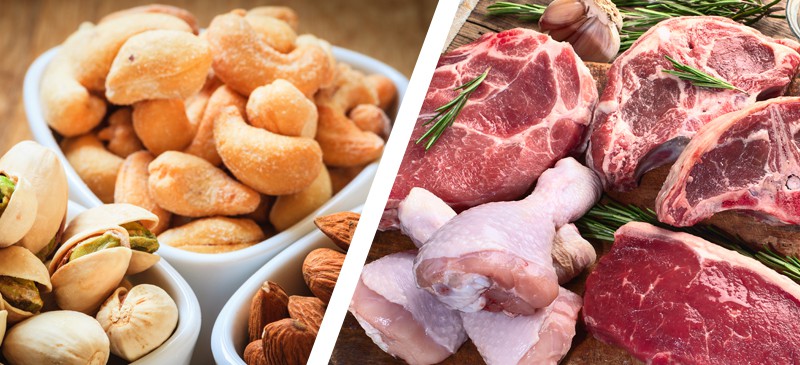This Dr. Axe content is medically reviewed or fact checked to ensure factually accurate information.
With strict editorial sourcing guidelines, we only link to academic research institutions, reputable media sites and, when research is available, medically peer-reviewed studies. Note that the numbers in parentheses (1, 2, etc.) are clickable links to these studies.
The information in our articles is NOT intended to replace a one-on-one relationship with a qualified health care professional and is not intended as medical advice.
This article is based on scientific evidence, written by experts and fact checked by our trained editorial staff. Note that the numbers in parentheses (1, 2, etc.) are clickable links to medically peer-reviewed studies.
Our team includes licensed nutritionists and dietitians, certified health education specialists, as well as certified strength and conditioning specialists, personal trainers and corrective exercise specialists. Our team aims to be not only thorough with its research, but also objective and unbiased.
The information in our articles is NOT intended to replace a one-on-one relationship with a qualified health care professional and is not intended as medical advice.
Valine: the Essential Amino Acid that Supports Athletic Performance
June 12, 2019

Why are amino acids “essential” or important to our health? Along with proteins, amino acids like valine are commonly referred to as “the building blocks of life.” Our bodies not only use amino acids as a form of energy, but they also take amino acids and synthesize proteins, which help us to grow, process the food we eat and repair bodily tissue. Amino acids classification options include being essential, nonessential or conditional.
Is valine essential or nonessential?
It is definitely an essential amino acid.
How many essential amino acids are there?
Valine is one of nine essential amino acids. The human body cannot create it, which is why it must be obtained from what you eat.
Thankfully, it’s not hard to get it in your diet by consuming protein-rich foods, such as grass-fed beef, wild-caught salmon, yogurt and quinoa, just to name a few sources. Is there ever a time when you may want to consider supplementing with this amino acid? We’re about to take a look at certain cases were a supplement may be helpful and also learn more about how you can get valine easily in a healthy, well-rounded diet.
What Is Valine? (Role in the Body)
In 1901, German chemist Emil Fischer was the first person to isolate valine from casein, a protein found in dairy products as well as breast milk. It is a building block of both plant and animal proteins.
Where would you find valine in a protein?
It’s found mostly in the interior of proteins.
L-valine is also one of several so-called “essential amino acids ” for humans as well as all mammals and fowl. The bodies of mammals and fowl cannot create it so they need to get it from food sources. An interesting fact about valine is that it can be synthesized in microorganisms and plants from pyruvic acid, which is a product of the breakdown of carbohydrates, proteins and fats.
Amino acids are the building blocks of protein and can be classified into three groups, including essential, nonessential and conditional amino acids. How do these groups differ?
- Essential amino acids definition: Amino acids that cannot be made by the body so they must be obtained through food (or supplements). The list of essential amino acids includes histidine, lysine, methionine, phenylalanine, threonine, tryptophan, leucine, isoleucine and valine.
- Nonessential amino acids definition: Nonessential means that our bodies are able to produce these amino acids even when we don’t consume them in our diets.
- Conditional or conditionally essential amino acids definition: These amino acids are considered essential only in times of illness and stress.
Valine is nonpolar (meaning it has no charge), and the valine melting point is 568 degrees Fahrenheit (298 degrees Celsius). It is a hydrophobic amino acid so it repels water molecules, and its chemical formula is C5H11NO2. What does valine structure look like? It is a branched chain amino acid (BCAA). This means its carbon structure is marked by a branch point. As a molecule, it looks like the letter “Y.”
Are amino acids and BCAAs the same thing?
Certain essential amino acids, specifically leucine, isoleucine and valine, are considered BCAAs, and the “branched chain” is a reference to the similar chemical structure of these three amino acids. BCAAs are known for their ability to encourage the building of protein in muscle and to possibly decrease muscle breakdown. They also appear to discourage problematic brain cell messaging that can occur in people with certain serious health conditions, including liver disease and anorexia.
In addition to promoting muscle growth and tissue repair, another valine function is its ability support both muscle coordination and mental strength while promoting an emotionally calm state. It is also key to optimal growth in children.
Valine Benefits
What are the benefits of valine?
Athletes and bodybuilders are best known for supplementing with this amino acid due to its ability to prevent muscle breakdown and boost athletic performance. How does it accomplish this? It helps supply the muscles with extra glucose for energy production during intense exercise.
Studies using both human subjects and animal subjects support this benefit. A clinical study published in 2017 finds that acute supplementation of BCAAs (0.087 g/kg) increased the rate of recovery in isometric strength and perceived muscle soreness compared to placebo after a hypertrophy-based training session among diet-controlled, resistance-trained athletes.
Another research study published in 2018 in the scientific journal Bioscience, Biotechnology, and Biochemistry specifically looked at the effects of valine on animal subjects during exercise. The results of the study demonstrate that acute supplementation of valine, but not leucine or isoleucine (the other BCAAs), is “effective for maintaining liver glycogen and blood glucose and increasing spontaneous activity after exercise, which could contribute to the reduction of fatigue during exercise.”
Supplementation with branch-chain amino acids has been used for the following with some success as well:
- Cirrhosis of the liver
- Phenylketonuria
- Athletic performance and mental decline during exercise at extreme temperature
- Athletic performance and post-exercise infection at extreme temperature
- Tardive dyskinesia
Risks and Side Effects
It’s important to stick to recommended product dosages of L-valine because excessive amounts may cause hallucinations and a skin-crawling sensation. Excessive valine may also cause high concentrations of toxic ammonia in the body along with decreased liver and kidney function.
Possible side effects of supplementation with BCAAs in general also include nausea, vomiting, diarrhea, stomach bloating, fatigue and loss of coordination. For this reason, people who supplement with L-valine should be especially careful when driving or being involved in other activities that require motor coordination. Rarely, branched-chain amino acids can lead to high blood pressure, headache or skin whitening.
Talk to your health care provider before supplementing with l-valine, especially if you have a medical condition and/or currently take medication.
Using a single amino acid supplement may lead to negative nitrogen balance. This can decrease how well your metabolism works and may also make your kidneys work harder. In children, taking single amino acid supplements may cause growth problems. In general, it’s typically not advised to take high doses of single amino acids for long periods of time.
People with the following conditions should avoid supplementation with BCAAs:
- Amyotrophic lateral sclerosis (ALS) aka Lou Gehrig’s disease
- Pregnant and breast-feeding women
- Branched-chain ketoaciduria
- Chronic alcoholism
- Maple syrup urine disease (MSUD)
It’s also advised that people with kidney or liver disease should not consume high amounts of amino acids without first consulting their doctors. Children should not supplement with BCAAs unless advised by their doctors. If you have upcoming surgery, stop supplementing with L-valine at least two weeks prior.
Foods and Supplements
Is valine an essential amino acid?
It sure is, which is why (as you learned earlier) you need to get it from food and/or supplements.
What foods are high in valine?
High-valine foods include:
- Dairy products, especially cottage cheese and yogurt
- Eggs
- Red meat like lamb and beef
- Fish, including wild-caught salmon and trout
- Fermented soy products, like natto and tempeh
- Turkey and chicken
- Seeds, including sunflower seeds, sesame seeds, flaxseeds and chia seeds
- Nuts, like pistachios, cashews and almonds
- Beans, including navy beans, kidney beans, adzuki beans, chickpeas and lentils
- Mushrooms
- Gluten-free whole grains, like quinoa and brown rice
L-valine supplements are commonly taken by weightlifters and performance athletes as part of their workout routines. People that are looking to increase their valine intake through supplements have a few options. One option is to take L-valine by itself. You can also take BCAA supplements that provide a balance of the amino acids L-leucine, L- isoleucine and L-valine. Both whey protein and egg protein supplements also contain BCAAs.
How to Use It (Plus Dosage)
The most notable signs of a valine deficiency are neurological defects in the brain. However, most people consume adequate amounts of this essential amino acid (about 25–65 milligrams per 2.2 pounds of body weight) through their diets. Someone who is likely to be deficient in valine would be someone who is deficient in protein in general.
Athletes taking part in intense training activities have been known to supplement with a daily intake of L-leucine, L-valine and L-isoleucine to avoid muscle loss and increase muscle gain.
L-valine can be taken alone, but it’s recommended to take it along with the other BCAAs, leucine and isoleucine. A common recommendation is to look for products that have a 2:1:1 ratio of leucine:isoleucine:valine.
Currently there is insufficient evidence to support an optimal dose of valine supplementation. It’s also unclear what health conditions clearly warrant supplementation with this amino acid.
Recipes
If you want to up your intake of valine, here are some delicious recipes with high-valine foods as the stars:
- Turkey Chili with Adzuki Beans Recipe
- Black Bean Quinoa Salad Recipe
- Strawberry Rhubarb Chia Seed Pudding Recipe
- Blackened Salmon Recipe with Creamy Avocado Dressing
Final Thoughts
- What kind of amino acid is valine? It’s an essential amino acid that the body cannot synthesize. Therefore it must be obtained through diet or supplements.
- As an amino acid, it is a “building block of life” that is essential for protein synthesis, which help us grow, process the food we eat and repair bodily tissue. Amino acids also act as energy sources for the body.
- You can easily consume a delicious and wide variety of protein-rich and valine-rich foods on a daily basis by eating things like wild-caught salmon, lamb, grass-fed beef, quinoa, beans, seeds, fermented soy products like natto and mushrooms.
- Eating a variety of both essential and nonessential amino acids daily is important to optimal health.
- L-valine supplements are most commonly taken by weightlifters and performance athletes.
- The “branched-chain” valine amino acid structure may make it especially helpful at muscle building while discouraging muscle breakdown.
- It’s not hard to consume enough of it through diet alone.
- Check with your health care provider before supplementing with valine.
Read Next: L-Glutamine Benefits Leaky Gut & Metabolism










